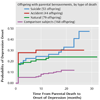The incidence and course of depression in bereaved youth 21 months after the loss of a parent to suicide, accident, or sudden natural death
- PMID: 19411367
- PMCID: PMC2768496
- DOI: 10.1176/appi.ajp.2009.08081244
The incidence and course of depression in bereaved youth 21 months after the loss of a parent to suicide, accident, or sudden natural death
Erratum in
-
Corrections to Kennard et al., Pham et al., Brent et al.Am J Psychiatry. 2019 Sep 1;176(9):764. doi: 10.1176/appi.ajp.2019.1769correction. Am J Psychiatry. 2019. PMID: 31474123 No abstract available.
Abstract
Objective: This study examined effects of bereavement 21 months after a parent's death, particularly death by suicide.
Method: The participants were 176 offspring, ages 7-25, of parents who died by suicide, accident, or sudden natural death. They were assessed 9 and 21 months after the death, along with 168 nonbereaved subjects.
Results: Major depression and alcohol or substance abuse 21 months after the parent's death were more common among bereaved youth than among comparison subjects. Offspring with parental suicide or accidental death had higher rates of depression than comparison subjects; those with parental suicide had higher rates of alcohol or substance abuse. Youth with parental suicide had a higher incidence of depression than those bereaved by sudden natural death. Bereavement and a past history of depression increased depression risk in the 9 months following the death, which increased depression risk between 9 and 21 months. Losing a mother, blaming others, low self-esteem, negative coping, and complicated grief were associated with depression in the second year.
Conclusions: Youth who lose a parent, especially through suicide, are vulnerable to depression and alcohol or substance abuse during the second year after the loss. Depression risk in the second year is mediated by the increased incidence of depression within the first 9 months. The most propitious time to prevent or attenuate depressive episodes in bereaved youth may be shortly after the parent's death. Interventions that target complicated grief and blaming of others may also improve outcomes in symptomatic youth with parental bereavement.
Figures


References
-
- Tremblay GC, Israel AC. Children’s adjustment to parental death. Clin Psychol Sci Prac. 1998;5:424–438.
-
- Dowdney L. Childhood bereavement following parental death. J Child Psychol Psychiatry. 2000;41:819–830. - PubMed
-
- Kendler KS, Sheth K, Gardner CO, Prescott CA. Childhood parental loss and risk for first-onset of major depression and alcohol dependence: the time-decay of risk and sex differences. Psychol Med. 2002;32:1187–1194. - PubMed
-
- Hollingshead AB. Four-Factor Index of Social Status. New Haven, Conn: Yale University, Department of Sociology; 1975.
Publication types
MeSH terms
Grants and funding
LinkOut - more resources
Full Text Sources
Other Literature Sources
Medical
Miscellaneous

